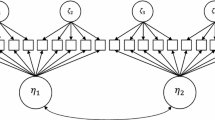Abstract
This study consists of four factor analyses of the Army Air Forces Aircrew Classification Batteries. The first was an analysis of the 1945 wartime battery, while the other three were analyses of the 1947 postwar battery, consisting of essentially the same variables, but using different samples. Eleven factors were found which had been identified and reported in previous analyses. An additional factor, possibly an artifact, was identified as an age-education doublet. The only factor which differed significantly in the analyses was pilot or flying interest. These factor analyses show that the factorial content of the tests remains quite similar in both wartime and postwar populations.
Similar content being viewed by others
References
Dailey, J. T., and Gragg, D. B. Postwar research on the classification of aircrew. San Antonio, Tex.: Human Resources Research Center, Lackland Air Force Base, November 1949. (Research Bulletin 49-2.)
French, J. W. The description of aptitude and achievement tests in terms of rotated factors. Psychometric Monograph No. 5. Chicago: Univ. Chicago Press, 1951.
Guilford, J. P. (Ed.) Printed classification tests. Army Air Forces Aviation Psychology Program Research Reports, Report No. 5. Washington: U. S. Government Printing Office, 1947.
Melton, A. W. (Ed.) Apparatus tests. Army Air Forces Aviation Psychology Program Research Reports, Report No. 4, Washington: U. S. Government Printing office, 1947.
Thurstone, L. L. Multiple-factor analysis. Chicago: Univ. Chicago Press, 1947.
Zachert, V., and Friedman, G. Factorial comparisons of two aircrew classification batteries with and without the variable of previous flying experience. San Antonio, Tex.: Human Resources Research Center, Lackland Air Force Base, April 1952. (Research Bulletin 52-16.)
Zimmerman, W. S. A simple graphical method for orthogonal rotation of axes.Psychometrika, 1946, 11, 51–56.
Author information
Authors and Affiliations
Additional information
The data reported in this study were collected as part of the United States Air Force Human Resources Research and Development Program and described in Research Bulletin 52-16. The opinions or conclusions contained in this report are those of the authors. They are not to be construed as reflecting the view or indorsement of the Department of the Air Force.
Rights and permissions
About this article
Cite this article
Zachert, V., Friedman, G. The stability of the factorial pattern of aircrew classification tests in four analyses. Psychometrika 18, 219–224 (1953). https://doi.org/10.1007/BF02289059
Received:
Revised:
Issue Date:
DOI: https://doi.org/10.1007/BF02289059




